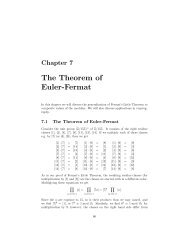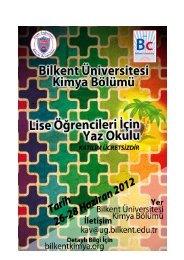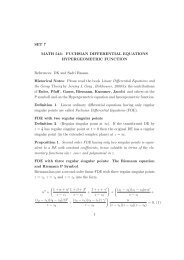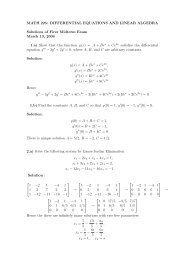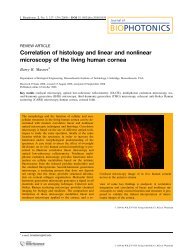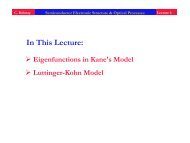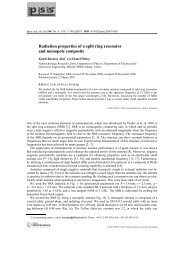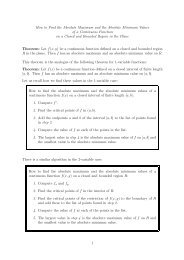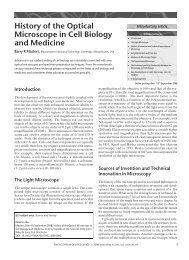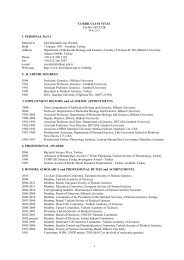Introduction to the English Edition of Hilbert's Zahlbericht
Introduction to the English Edition of Hilbert's Zahlbericht
Introduction to the English Edition of Hilbert's Zahlbericht
Create successful ePaper yourself
Turn your PDF publications into a flip-book with our unique Google optimized e-Paper software.
<strong>Introduction</strong><br />
<strong>to</strong> <strong>the</strong> <strong>English</strong> <strong>Edition</strong> <strong>of</strong> Hilbert’s <strong>Zahlbericht</strong><br />
1 The Report<br />
Franz Lemmermeyer Norbert Schappacher ∗<br />
September 11, 2003<br />
David Hilbert’s (1862–1943) so-called <strong>Zahlbericht</strong> <strong>of</strong> 1897, 1 which appears here for <strong>the</strong><br />
first time in <strong>English</strong>, was <strong>the</strong> principal textbook on algebraic number <strong>the</strong>ory for a period<br />
<strong>of</strong> at least thirty years after its appearance. Emil Artin, Helmut Hasse, Erich Hecke,<br />
Hermann Weyl and many o<strong>the</strong>rs learned <strong>the</strong>ir number <strong>the</strong>ory from this book. Even<br />
beyond this immediate impact Hilbert’s <strong>Zahlbericht</strong> has served as a model for many<br />
standard textbooks on algebraic number <strong>the</strong>ory through <strong>the</strong> present day—cf. for instance<br />
Samuel’s little book, 2 or <strong>the</strong> first chapter <strong>of</strong> Neukirch’s textbook. 3 As a matter <strong>of</strong> fact,<br />
except for minor details (see Section 4 below), at least <strong>the</strong> first two parts <strong>of</strong> Hilbert’s text<br />
can still <strong>to</strong>day pass for an excellent introduction <strong>to</strong> classical algebraic number <strong>the</strong>ory.<br />
But even though Hilbert’s presentation definitely left its mark on this material, <strong>the</strong><br />
text does remain a Bericht, i.e., a report, commissioned as it was by <strong>the</strong> Deutsche<br />
Ma<strong>the</strong>matiker-Vereinigung (D.M.V., <strong>the</strong> German Ma<strong>the</strong>matical Society), on <strong>the</strong> state<br />
<strong>of</strong> <strong>the</strong> <strong>the</strong>ory around 1895. During <strong>the</strong> first years <strong>of</strong> its existence, <strong>the</strong> commissioning <strong>of</strong><br />
comprehensive reports on all parts <strong>of</strong> ma<strong>the</strong>matics was an important part <strong>of</strong> <strong>the</strong> activities<br />
<strong>of</strong> <strong>the</strong> D.M.V. The first ten volumes <strong>of</strong> <strong>the</strong> Jahresbericht contain thirteen such reports.<br />
David Hilbert and Hermann Minkowski were asked <strong>to</strong> write a joint report covering all<br />
<strong>of</strong> number <strong>the</strong>ory. Eventually Hilbert and Minkowski decided <strong>to</strong> split <strong>the</strong> report, and it<br />
was agreed that Minkowski’s part should cover <strong>the</strong> elementary aspects <strong>of</strong> number <strong>the</strong>ory<br />
like continued fractions, quadratic forms and <strong>the</strong> geometry <strong>of</strong> numbers. But in <strong>the</strong> end,<br />
∗The authors would like <strong>to</strong> thank René Scho<strong>of</strong> for helpful comments during <strong>the</strong> preparation <strong>of</strong> this<br />
introduction.<br />
1D. Hilbert, Die Theorie der algebraischen Zahlkörper, Jahresbericht der Deutschen Ma<strong>the</strong>matiker-<br />
Vereinigung 4 (1897), pp. 175–546, re-edited in D. Hilbert, Gesammelte Abhandlungen, vol. 1, Berlin,<br />
Heidelberg, etc.: Springer, 1932 (second edition 1970), pp. 63–363. — A French edition appeared in 1910<br />
(never mind its printed date): D. Hilbert, Théorie des corps de nombres algébriques, traduit par M.A.<br />
Lewy (pr<strong>of</strong>esseur au lycée Voltaire), Annales de la Faculté des Sciences de l’Université de Toulouse, 1909,<br />
3e fasc.<br />
2 P. Samuel, Théorie algébrique des nombres, Paris: Hermann, 1967.<br />
3J. Neukirch, Algebraische Zahlen<strong>the</strong>orie, Heidelberg etc.: Springer, 1992.<br />
1
only Hilbert’s part was actually written. It is interesting <strong>to</strong> compare Hilbert’s <strong>Zahlbericht</strong><br />
for instance <strong>to</strong> <strong>the</strong> monumental report by A. Brill and M. Noe<strong>the</strong>r “on <strong>the</strong> development<br />
<strong>of</strong> <strong>the</strong> <strong>the</strong>ory <strong>of</strong> algebraic functions in former and recent times,” 4 which is much more<br />
obviously his<strong>to</strong>rically oriented than Hilbert’s <strong>Zahlbericht</strong>, and much less <strong>of</strong> a systematic<br />
introduction <strong>to</strong> <strong>the</strong> field. On <strong>the</strong> applied side, <strong>the</strong>re was for example a report on <strong>the</strong><br />
development and <strong>the</strong> main tasks <strong>of</strong> <strong>the</strong> <strong>the</strong>ory <strong>of</strong> simple frameworks. 5<br />
Because it is above all a report, it is not in <strong>the</strong> <strong>Zahlbericht</strong> that one finds Hilbert’s<br />
most important, original contributions <strong>to</strong> number <strong>the</strong>ory—although it does include Hilbert’s<br />
pro<strong>of</strong> <strong>of</strong> <strong>the</strong> Kronecker-Weber <strong>the</strong>orem 6 as well as <strong>the</strong> <strong>the</strong>ory <strong>of</strong> higher ramification<br />
groups, i.e., Hilbert’s development from <strong>the</strong> early 1890s <strong>of</strong> Dedekind’s arithmetic <strong>the</strong>ory<br />
<strong>of</strong> Galois extensions <strong>of</strong> number fields. Indeed, Hilbert’s most impressive original contribution<br />
<strong>to</strong> number <strong>the</strong>ory came after <strong>the</strong> <strong>Zahlbericht</strong>; it was his conjectural anticipation <strong>of</strong><br />
most <strong>of</strong> <strong>the</strong> <strong>the</strong>orems <strong>of</strong> Class Field Theory, based on a remarkably deep analysis <strong>of</strong> <strong>the</strong><br />
arithmetic <strong>of</strong> quadratic extensions <strong>of</strong> number fields. This work appeared in two articles,<br />
in 1899 and 1902. The reader interested in this aspect <strong>of</strong> Hilbert’s œuvre will still have <strong>to</strong><br />
read German—see <strong>the</strong> first volume <strong>of</strong> Hilbert’s Gesammelte Abhandlungen and Hasse’s<br />
appreciation <strong>of</strong> Hilbert’s number <strong>the</strong>oretical achievements <strong>the</strong>rein. 7<br />
Coming back <strong>to</strong> <strong>the</strong> <strong>Zahlbericht</strong>, for Hilbert reporting on <strong>the</strong> state <strong>of</strong> algebraic number<br />
<strong>the</strong>ory did not mean writing an inven<strong>to</strong>ry <strong>of</strong> <strong>the</strong>orems amassed in <strong>the</strong> course <strong>of</strong> <strong>the</strong><br />
nineteenth century, 8 but ra<strong>the</strong>r <strong>the</strong> production <strong>of</strong> a conceptually coherent <strong>the</strong>ory, which<br />
would <strong>the</strong>n also point <strong>the</strong> way <strong>to</strong> fur<strong>the</strong>r research. It is because <strong>of</strong> this goal: <strong>to</strong> indicate,<br />
and <strong>the</strong>reby influence future directions <strong>of</strong> research, that Hilbert’s undertaking is most<br />
ambitious, and most open <strong>to</strong> criticism. Such criticism is <strong>of</strong> course easy <strong>to</strong> voice <strong>to</strong>day,<br />
because we can base our judgement on ano<strong>the</strong>r one hundred years <strong>of</strong> number <strong>the</strong>oretic<br />
research. Still, it is nei<strong>the</strong>r futile, nor is it a priori unjust, <strong>to</strong> put Hilbert’s text in<strong>to</strong> this<br />
perspective, because <strong>the</strong> <strong>Zahlbericht</strong> was precisely written with <strong>the</strong> idea <strong>of</strong> steering <strong>the</strong><br />
4 A. Brill, M. Noe<strong>the</strong>r, Bericht über die Entwicklung der Theorie der algebraischen Funktionen in<br />
älterer und neuerer Zeit, Jahresbericht der Deutschen Ma<strong>the</strong>matiker-Vereinigung 3 (1892–93), pp. 107–<br />
565. 5L. Henneberg, Bericht über die Entwicklung und die Hauptaufgaben der Theorie der einfachen Fachwerke,<br />
Jahresbericht der Deutschen Ma<strong>the</strong>matiker-Vereinigung 3 (1892–93), pp. 567–599.<br />
6 For a review <strong>of</strong> early (purported) pro<strong>of</strong>s <strong>of</strong> this <strong>the</strong>orem, see O. Neumann, Two pro<strong>of</strong>s <strong>of</strong> <strong>the</strong><br />
Kronecker-Weber <strong>the</strong>orem “according <strong>to</strong> Kronecker, and Weber”, J. Reine Angew. Math. 323 (1981),<br />
105–126, in particular p. 125, and N. Schappacher, On <strong>the</strong> His<strong>to</strong>ry <strong>of</strong> Hilbert’s Twelfth Problem, I: Paris<br />
1900 – Zürich 1932: The Comedy <strong>of</strong> Errors, in: Matériaux pour l’his<strong>to</strong>ire des mathématiques au XX<br />
siècle, Actes du colloque à la mémoire de Jean Dieudonné (Nice, 1996), “Séminaires et Congrès” 3<br />
(1998), 243–273.<br />
7 D. Hilbert, Gesammelte Abhandlungen, vol. 1, Berlin, Heidelberg, etc.: Springer, 1970. Hasse’s note:<br />
“Zu Hilberts algebraisch-zahlen<strong>the</strong>oretischen Arbeiten,” is on pp. 528–535.<br />
8 This may be what <strong>the</strong> D.M.V. had in mind, as <strong>the</strong>y certainly were aware <strong>of</strong> H.J.S. Smith’s report on<br />
<strong>the</strong> <strong>the</strong>ory <strong>of</strong> numbers [Collected Ma<strong>the</strong>matical Papers 1, 38–364] presented <strong>to</strong> <strong>the</strong> London Ma<strong>the</strong>matical<br />
Society, which is an invaluable document for anyone interested in <strong>the</strong> number <strong>the</strong>ory <strong>of</strong> <strong>the</strong> 19th century,<br />
but lacks <strong>the</strong> coherence <strong>of</strong> Hilbert’s <strong>Zahlbericht</strong>. — One should also mention Paul Bachmann’s work<br />
in five volumes, <strong>the</strong> fifth volume <strong>of</strong> which was already written under <strong>the</strong> influence <strong>of</strong> Hilbert’s <strong>Zahlbericht</strong>:<br />
P. Bachmann, Zahlen<strong>the</strong>orie, Versuch einer Gesammtdarstellung, Leipzig: Teubner; vol. I, Die<br />
Elemente der Zahlen<strong>the</strong>orie (1892); vol. II, Die Analytische Zahlen<strong>the</strong>orie (1894); vol. III, Die Lehre von<br />
der Kreis<strong>the</strong>ilung (1872); vol. IV, Die Arithmetik der quadratischen Formen (part 1, 1898; part 2, 1923);<br />
vol. V, Allgemeine Arithmetik der Zahlkörper (1905).<br />
2
fur<strong>the</strong>r development <strong>of</strong> <strong>the</strong> <strong>the</strong>ory.<br />
2 Later Criticism<br />
Probably <strong>the</strong> most outspoken criticism <strong>of</strong> tendencies expressed in <strong>the</strong> <strong>Zahlbericht</strong> that<br />
has been published by an eminent number <strong>the</strong>orist is due <strong>to</strong> André Weil and concerns<br />
specifically Hilbert’s treatment, in <strong>the</strong> latter parts <strong>of</strong> <strong>the</strong> work, <strong>of</strong> Kummer’s arithmetic<br />
<strong>the</strong>ory <strong>of</strong> <strong>the</strong> cyclo<strong>to</strong>mic field <strong>of</strong> ℓ-th roots <strong>of</strong> unity, for a regular prime number ℓ. In fact,<br />
Weil’s introduction <strong>to</strong> Kummer’s Collected Papers begins: 9<br />
The great number-<strong>the</strong>orists <strong>of</strong> <strong>the</strong> last century are a small and select group <strong>of</strong><br />
men. . . . Most <strong>of</strong> <strong>the</strong>m were no sooner dead than <strong>the</strong> publication <strong>of</strong> <strong>the</strong>ir<br />
collected papers was undertaken and in due course brought <strong>to</strong> completion.<br />
To this <strong>the</strong>re were two notable exceptions: Kummer and Eisenstein. Did<br />
one die <strong>to</strong>o young and <strong>the</strong> o<strong>the</strong>r live <strong>to</strong>o long? Were <strong>the</strong>re o<strong>the</strong>r reasons for<br />
this neglect, more personal and idiosyncratic perhaps than scientific? Hilbert<br />
dominated German ma<strong>the</strong>matics for many years after Kummer’s death [in<br />
1893]. More than half <strong>of</strong> his famous <strong>Zahlbericht</strong> (viz., parts IV and V) is little<br />
more than an account <strong>of</strong> Kummer’s number-<strong>the</strong>oretical work, with inessential<br />
improvements; but his lack <strong>of</strong> sympathy for his predecessor’s ma<strong>the</strong>matical<br />
style, and more specifically for his brilliant use <strong>of</strong> p-adic analysis, shows clearly<br />
through many <strong>of</strong> <strong>the</strong> somewhat grudging references <strong>to</strong> Kummer in that volume.<br />
It seems difficult <strong>to</strong> prove—or <strong>to</strong> disprove, for that matter—Weil’s suspicion that it was<br />
Hilbert’s influence which prevented <strong>the</strong> timely publication <strong>of</strong> Kummer’s collected papers.<br />
Hilbert and Minkowski in <strong>the</strong>ir correspondence about <strong>the</strong> <strong>Zahlbericht</strong>—at a time when<br />
Minkowski was still trying <strong>to</strong> contribute his share <strong>to</strong> a more extensive report on number<br />
<strong>the</strong>ory—deplore <strong>the</strong> fact (and blame <strong>the</strong> Berlin Academy for it) that Eisenstein’s collected<br />
papers had not been published. 10 An analogous comment by Hilbert or Minkowski about<br />
Kummer’s collected papers is not known; instead, <strong>the</strong>re is direct evidence that Hilbert<br />
complained <strong>to</strong> Minkowski about how unpleasant he found it <strong>to</strong> have <strong>to</strong> work through<br />
Kummer’s papers. 11 This is also evident in <strong>the</strong> <strong>Zahlbericht</strong>; for instance in <strong>the</strong> preface:<br />
9 E.E. Kummer, Collected Papers, edited by André Weil, vol. 1, Heidelberg etc.: Springer, 1975, p. 1.<br />
10 See H. Minkowski, Briefe an David Hilbert, mit Beiträgen und herausgegeben von L. Rüdenberg und<br />
H. Zassenhaus, Berlin, Heidelberg, New York: Springer, 1973, p. 72, Minkowski <strong>to</strong> Hilbert 12-4-1895:<br />
“Eisensteins Werke gesammelt herauszugeben, wäre wirklich eine Pflicht und ausgeführt ein Verdienst;<br />
und für die Berliner Akademie wäre es eine ewige und wohlverdiente Schande, wenn jemand sonst dieses<br />
Unternehmen angriffe.”<br />
11 See loc. cit., p. 75f, Minkowski <strong>to</strong> Hilbert 22-1-1896: “Ich bin doch etwas zu spät an das Referat<br />
gegangen. Jetzt finde ich natürlich viele hübsche Probleme, von denen es ganz schön gewesen wäre, wenn<br />
ich sie erledigt hätte. Die Jordanschen Aufsätze sind eigentlich recht interessant. Aber wenn Dir schon<br />
die Kummerschen Rechnungen unangenehm waren, so würden die Jordanschen Operationen, sein ‘pour<br />
fixer les idées’ Dir einen wahren Ekel einjagen.”<br />
3
“I have tried <strong>to</strong> avoid Kummer’s elaborate computational machinery, so that here <strong>to</strong>o<br />
Riemann’s principle may be realized and <strong>the</strong> pro<strong>of</strong>s completed not by calculations but by<br />
pure thought.” 12<br />
Readers <strong>of</strong> <strong>the</strong> first generation, echoing Hilbert’s announcement, have praised <strong>the</strong><br />
<strong>Zahlbericht</strong> in particular for having simplified Kummer. 13 Thus Hasse in 1932 mentions<br />
Kummer’s “complicated and less than transparent pro<strong>of</strong>s”, which Hilbert replaced by new<br />
ones. 14 In 1951, however, Hasse added an afterthought describing <strong>the</strong> two rival traditions<br />
in <strong>the</strong> his<strong>to</strong>ry <strong>of</strong> number <strong>the</strong>ory: on <strong>the</strong> one hand, <strong>the</strong>re is <strong>the</strong> Gauss-Kummer tradition<br />
which aims at explicit, constructive control <strong>of</strong> <strong>the</strong> objects studied, and which was carried<br />
on in particular by Kronecker and Hensel. The Dedekind-Hilbert tradition, on <strong>the</strong> o<strong>the</strong>r<br />
hand, aims above all at conceptual understanding. Although less critical <strong>of</strong> <strong>the</strong> <strong>Zahlbericht</strong><br />
than Weil, Hasse saw <strong>the</strong> need <strong>to</strong> plead for an “organic equilibrium” <strong>of</strong> both approaches<br />
<strong>to</strong> number <strong>the</strong>ory, as opposed <strong>to</strong> <strong>the</strong> “domination” <strong>of</strong> Hilbert’s approach. 15<br />
12D. Hilbert, Gesammelte Abhandlungen, vol. 1, Berlin, Heidelberg, etc.: Springer, 1970, p. 67 (cf. p.<br />
VIII <strong>of</strong> <strong>the</strong> translation below): “Ich habe versucht, den großen rechnerischen Apparat von Kummer zu<br />
vermeiden, damit auch hier der Grundsatz von Riemann verwirklicht würde, demzufolge man die Beweise<br />
nicht durch Rechnungen, sondern lediglich durch Gedanken zwingen soll.” The picture <strong>of</strong> Riemann that<br />
Hilbert alludes <strong>to</strong> here was central in Felix Klein’s campaign <strong>to</strong> elevate Riemann beyond comparison.<br />
For instance, Klein confronted Riemann with Eisenstein, whom he called a Formelmensch, a man <strong>of</strong><br />
formulas. A nice tit for tat is <strong>to</strong> be found in Carl Ludwig Siegel’s article Über Riemanns Nachlaß zur<br />
analytischen Zahlen<strong>the</strong>orie from 1932—see C.L. Siegel, Werke, edited by Chandrasekharan and Maaß,<br />
New York, Berlin, etc.: Springer, vol. I, p. 276, where Siegel, after having gone through Riemann’s<br />
formidable handwritten notes on <strong>the</strong> zeta function, remarks: “The legend according <strong>to</strong> which Riemann<br />
found <strong>the</strong> results <strong>of</strong> his ma<strong>the</strong>matical work via ‘big general’ ideas, without using <strong>the</strong> formal <strong>to</strong>ols <strong>of</strong><br />
analysis, does not seem <strong>to</strong> be as widespread any more as in Klein’s time.”<br />
13Hilbert’s pro<strong>of</strong>reader and friend Minkowski, however, was less enthusiastic when he read Hilbert’s<br />
treatment <strong>of</strong> Kummer’s <strong>the</strong>ory for <strong>the</strong> first time: He found <strong>the</strong> calculations still ra<strong>the</strong>r “involved,” and<br />
Hilbert’s pro<strong>of</strong> <strong>of</strong> <strong>the</strong> reciprocity law “not easy <strong>to</strong> read.” — see H. Minkowski, Briefe an D. Hilbert,<br />
mit Beiträgen und herausgegeben von L. Rüdenberg und H. Zassenhaus, Berlin, Heidelberg, New York:<br />
Springer, 1973, p. 86: Minkowski <strong>to</strong> Hilbert 17-11-1896: “. . . 20 Seiten habe ich bereits durchgesehen,<br />
bis zu der Stelle [around §126?], wo die langen Rechnungen anfangen. Sie sind doch noch ziemlich<br />
verwickelt.” and p. 92, Minkowski <strong>to</strong> Hilbert 31-1-1897: “Dein Beweis des Reziprozitätsgesetzes ist nicht<br />
leicht zu lesen.” Minkowski’s subsequent sentence indicates that this refers <strong>to</strong> <strong>the</strong> pro<strong>of</strong> given in §§155–161<br />
<strong>of</strong> <strong>the</strong> <strong>Zahlbericht</strong>. At this point, Minkowski may not have known yet that Hilbert was going <strong>to</strong> give an<br />
alternative pro<strong>of</strong> in §§166–171 <strong>of</strong> <strong>the</strong> <strong>Zahlbericht</strong>.<br />
14D. Hilbert, Gesammelte Abhandlungen, vol. 1, Berlin, Heidelberg, etc.: Springer, 1970, p. 529:<br />
“Hilbert gibt hier neue, von den umständlichen und wenig durchsichtigen Rechnungen Kummers freie<br />
Beweise.”<br />
15 See H. Hasse, Über die Klassenzahl abelscher Zahlkörper, Berlin: Akademie-Verlag, 1952; Reprint<br />
Berlin etc.: Springer, 1985, p. VII – VIII: “Der Sinn dafür, daß die explizite Beherrschung des Gegenstandes<br />
bis in alle Einzelheiten mit der allgemeinen Fortentwicklung der Theorie Schritt halten sollte,<br />
war bei Gauss und später vor allem noch bei Kummer in ganz ausgeprägter Weise vorhanden. . . . Unter<br />
dem beherrschenden Einfluß, den Hilbert auf die weitere Entwicklung der algebraischen Zahlen<strong>the</strong>orie<br />
ausgeübt hat, ist jedoch dieser Sinn mehr und mehr verlorengegangen. Es ist typisch für Hilberts ganz<br />
auf das Allgemeine und Begriffliche, auf Existenz und Struktur gerichteten Einstellung, daß er in seinem<br />
<strong>Zahlbericht</strong> alle mit der expliziten Beherrschung des Gegenstandes sich befassenden Untersuchungen und<br />
Ergebnisse von Kummer und anderen durch kurze Hinweise oder Andeutungen abtut, ohne sich mit ihnen<br />
im einzelnen zu beschäftigen, wie er ja auch die mehr rechnerischen, konstruktiven und daher der<br />
expliziten Durchführung leicht zugänglichen Beweismethoden Kummers systematisch und folgerichtig<br />
durch mehr begriffliche, numerisch schwerer zugängliche und kaum kontrollierbare Schlußweisen ersetzt<br />
4
Emil Artin, in an address for a general audience given on <strong>the</strong> occasion <strong>of</strong> Hilbert’s<br />
100th birthday in 1962, acknowledged <strong>the</strong> “great simplification” that Hilbert achieved<br />
in presenting Kummer’s results. 16 According <strong>to</strong> Olga Taussky’s recollections, however,<br />
“it was only . . . at Bryn Mawr, that Emmy [Noe<strong>the</strong>r] burst out against <strong>the</strong> <strong>Zahlbericht</strong>,<br />
quoting also Artin as having said that it delayed <strong>the</strong> development <strong>of</strong> algebraic number<br />
<strong>the</strong>ory by decades.” 17 We have no way <strong>of</strong> knowing what Emmy Noe<strong>the</strong>r might have<br />
had in mind when she made <strong>the</strong> remark remembered by Taussky, and we do not want<br />
<strong>to</strong> speculate on this. Let us look instead a bit more closely at Hilbert’s treatment <strong>of</strong><br />
Kummer’s <strong>the</strong>ory.<br />
3 Kummer’s Theory<br />
The results <strong>of</strong> Kummer’s <strong>the</strong>ory which both Hilbert and Weil, in rare unison, refer <strong>to</strong> as<br />
<strong>the</strong> highest peak <strong>of</strong> Kummer’s number <strong>the</strong>oretic work 18 were <strong>the</strong> general reciprocity law<br />
for ℓ-th power residues, in <strong>the</strong> case <strong>of</strong> a regular odd prime number ℓ, <strong>to</strong>ge<strong>the</strong>r with <strong>the</strong><br />
<strong>the</strong>ory <strong>of</strong> genera in a Kummer extension <strong>of</strong> Q(ζℓ) which had <strong>to</strong> be developed along <strong>the</strong> way.<br />
Hilbert refers <strong>to</strong> both as <strong>the</strong> arithmetic <strong>the</strong>ory <strong>of</strong> Kummer fields. The general reciprocity<br />
law is first dealt with in <strong>the</strong> <strong>Zahlbericht</strong> in §§154–165, based on Eisenstein’s reciprocity<br />
law which relates a rational <strong>to</strong> an arbitrary cyclo<strong>to</strong>mic integer. The reciprocity law and its<br />
Ergänzungssätze (complementary <strong>the</strong>orems) are stated as Satz 161. Hilbert’s presentation<br />
hat. Auch Dedekind mit seiner stark begrifflichen, schon tief ins Axiomatische vors<strong>to</strong>ßenden Methodik<br />
hat an dieser Entwicklung entscheidenden Anteil, während auf der andern Seite die mehr konstruktiven<br />
Methoden von Kronecker und Hensel die Kummersche Tradition weiterführen, sich aber gegenüber dem<br />
beherrschenden Einfluß Hilberts nur schwer durchsetzen, bis dann allerdings in letzter Zeit entscheidende<br />
Erfolge gerade dieser Methodik den Boden für die Rückkehr zu einem organischen Gleichgewicht beider<br />
Richtungen bereitet haben.”<br />
Zassenhaus shares Hasse’s point <strong>of</strong> view in his note Zur Vorgeschichte des <strong>Zahlbericht</strong>s, in: H.<br />
Minkowski, Briefe an D. Hilbert, mit Beiträgen und herausgegeben von L. Rüdenberg und H. Zassenhaus,<br />
Berlin, Heidelberg, New York: Springer, 1973, p. 17–21): “Andererseits hat D. Hilbert mit<br />
charakteristischer Energie, aber auch, his<strong>to</strong>risch gesehen, mit einer gewissen Einseitigkeit praktisch die<br />
Disziplin der algebraischen Zahlkörper<strong>the</strong>orie aus dem his<strong>to</strong>risch gegebenen Material herausmodelliert.”<br />
16E. Artin, Collected Papers, New York, Berlin, etc.: Springer, 1965, p. 549: Hilbert “machte durch<br />
große Vereinfachung die Ergebnisse Kummers einem größeren Leserkreis zugänglich.”<br />
17See Emmy Noe<strong>the</strong>r, a tribute <strong>to</strong> her life and work, edited by Brewer and Smith, M. Dekker 1981,<br />
p. 82, cf. p. 90. — Olga Taussky was one <strong>of</strong> <strong>the</strong> young ma<strong>the</strong>maticians who helped with <strong>the</strong> editing<br />
<strong>of</strong> <strong>the</strong> first volume <strong>of</strong> Hilbert’s Gesammelte Abhandlungen. She claims loc. cit. that Hilbert’s original<br />
publications were full <strong>of</strong> errors <strong>of</strong> all kinds. But <strong>the</strong> only changes made by <strong>the</strong> edi<strong>to</strong>rs <strong>of</strong> <strong>the</strong> collected<br />
works that we are aware <strong>of</strong> is <strong>the</strong> unfortunate replacement, in Hilbert’s article Über den Dirichlet’schen<br />
biquadratischen Zahlkörper [Math. Ann. 45 (1894), 309–340], <strong>of</strong> <strong>the</strong> somewhat unusual abbreviation<br />
“bzglf.” for “bezüglichenfalls” in Hilbert’s original text, meaning “respectively,” by <strong>the</strong> word “bezüglich,”<br />
which means “with respect <strong>to</strong>”.<br />
18D. Hilbert, Gesammelte Abhandlungen, vol. 1, Berlin, Heidelberg, etc.: Springer, 1970, p. 66 (p. VIII<br />
<strong>of</strong> <strong>the</strong> following translation): “Es ist die Theorie dieses Kummerschen Körpers <strong>of</strong>fenbar auf der Höhe des<br />
heutigen arithmetischen Wissens die äußerste erreichte Spitze . . . ” — E.E. Kummer, Collected Papers,<br />
edited by André Weil, vol. 1, Heidelberg etc.: Springer, 1975, p. 9: “This is <strong>the</strong> peak he [Kummer] sighted<br />
for <strong>the</strong> first time in January 1848, and whose summit he reached ten years later.”<br />
5
makes sytematic use <strong>of</strong> <strong>the</strong> power residue symbol (see in particular <strong>the</strong> momen<strong>to</strong>us and<br />
original Satz 150 <strong>of</strong> <strong>the</strong> <strong>Zahlbericht</strong>), as well as <strong>the</strong> local Hilbert symbols. At <strong>the</strong> bad places<br />
<strong>the</strong> latter are given explicitly by Kummer’s logarithmic derivatives—see §131. Today we<br />
would call this an “explicit reciprocity law,” in <strong>the</strong> sense <strong>of</strong> <strong>the</strong> research development given<br />
new impetus in <strong>the</strong> late 1920s by Artin and Hasse and which continues <strong>to</strong> <strong>the</strong> present<br />
day. 19 The product formula for <strong>the</strong> local Hilbert symbols, i.e., “Hilbert’s reciprocity law,”<br />
appears in this treatment almost negligently as an auxiliary result, Satz 163 in §162.<br />
However, once Hilbert has established all <strong>of</strong> Kummer’s <strong>the</strong>ory, he sets out afresh, in<br />
§§166–171, <strong>to</strong> reprove all <strong>of</strong> it, but avoiding this time Kummer’s explicit formulæ for<br />
<strong>the</strong> symbols at <strong>the</strong> bad places, and controlling <strong>the</strong>m instead via <strong>the</strong> product <strong>the</strong>orem,<br />
by information ga<strong>the</strong>red at <strong>the</strong> primes not dividing ℓ. It may have been especially this<br />
second presentation <strong>of</strong> Kummer’s <strong>the</strong>ory that struck readers as a simplification, or at<br />
least as a way <strong>to</strong> get rid <strong>of</strong> Kummer’s computational approach. Weil’s wholesale claim<br />
quoted above, <strong>to</strong> <strong>the</strong> effect that Hilbert had only “inessential improvements” <strong>to</strong> <strong>of</strong>fer on<br />
Kummer’s <strong>the</strong>ory, does not seem <strong>to</strong> do justice <strong>to</strong> Hilbert’s double attempt <strong>to</strong> come <strong>to</strong><br />
grips with this <strong>the</strong>ory, even though, <strong>of</strong> course, whe<strong>the</strong>r or not his presentation is seen as<br />
an improvement over Kummer may be in <strong>the</strong> mind <strong>of</strong> <strong>the</strong> beholder.<br />
Working up <strong>to</strong>wards his general reciprocity law, Kummer’s central achievement was <strong>to</strong><br />
build up genus <strong>the</strong>ory for Kummer extensions <strong>of</strong> Q(ζℓ). Accordingly, genus <strong>the</strong>ory plays<br />
a very important role in <strong>the</strong> <strong>Zahlbericht</strong>. This is quite different from what we are used <strong>to</strong><br />
nowadays: for instance, <strong>the</strong> books by Samuel or Neukirch cited above never even mention<br />
genus <strong>the</strong>ory. One reason for its disappearance in our time was Chevalley’s introduction<br />
<strong>of</strong> idèles, which made it possible <strong>to</strong> develop class field <strong>the</strong>ory without going through <strong>the</strong><br />
no<strong>to</strong>rious index calculus <strong>of</strong> <strong>the</strong> ideal-<strong>the</strong>oretic approach via genus <strong>the</strong>ory. 20 Let us take a<br />
closer look at how genus <strong>the</strong>ory is treated in Hilbert’s <strong>Zahlbericht</strong>.<br />
19 P. Furtwängler, Die Reziprozitätsgesetze für Potenzreste mit Primzahlexponenten in algebraischen<br />
Zahlkörpern I, II, III, Math. Ann. 67 (1909), 1–31; 72 (1912), 346–386; 74 (1913), 413–429; T. Takagi,<br />
Über das Reziprozitätsgesetz in einem beliebigen algebraischen Zahlkörper, J. <strong>of</strong> <strong>the</strong> College <strong>of</strong> Science<br />
Tokyo 4 (1922); Coll. Papers, 179–216; E. Artin & H. Hasse, Die beiden Ergänzungssätze zum Rezipro-<br />
zitätsgesetz der l n -ten Potenzreste im Körper der l n -ten Einheitswurzeln, Abh. Math. Sem. Hamburg 6<br />
(1928), 146–142; Coll. Papers Artin (1965), 142–158; H. Hasse, Über das Reziprozitätsgesetz der m-ten<br />
Potenzreste, J. Reine Angew. Math. 158 (1927), 228–259; Math. Abh. I, 294–325; K. Iwasawa, On<br />
explicit formulas for <strong>the</strong> norm residue symbol, J. Math. Soc. Japan 20 (1968), 151–165; I. Shafarevich,<br />
A general reciprocity law, Am. Math. Soc. Transl. 4 (1956), 73–106; J. Coates, A. Wiles, Explicit reciprocity<br />
laws, Journées arithm. Caen 1976, Astérisque 41/42 (1977), 7–17; A. Wiles, Higher reciprocity<br />
laws, Ann. Math. 107 (1978), 235–254; A. Brückner, Explizites Reziprozitätsgesetz und Anwendungen,<br />
Vorlesungen aus dem Fachbereich Ma<strong>the</strong>matik der Universität Essen, 1979; G. Henniart, Sur les lois de réciprocité<br />
explicites, J. Reine Angew. Math. 329 (1981), 177–203; B. Perrin-Riou, Théorie d’Iwasawa des<br />
représentations p-adiques sur un corps local, Inventiones Math. 115 (1994), 81–149; K. Ka<strong>to</strong>, General<br />
explicit reciprocity laws; <strong>to</strong> appear in <strong>the</strong> forthcoming first volume <strong>of</strong> <strong>the</strong> Korean journal: Advanced<br />
Studies in Ma<strong>the</strong>matics; as well as recent unpublished work by P. Colmez as well as by F. Cherbonnier<br />
& P. Colmez [<strong>to</strong> appear in Journal AMS]. — With <strong>the</strong>se last papers, his<strong>to</strong>ry has come around full circle<br />
in that <strong>the</strong> “explicit” laws have <strong>the</strong>mselves been absorbed in<strong>to</strong> a new general abstract <strong>the</strong>ory.<br />
20See for instance Hasse’s <strong>Zahlbericht</strong>, I §6, p. 23–24; Ia, §10, §§12–16. — Helmut Hasse’s follow-up<br />
<strong>to</strong> Hilbert’s <strong>Zahlbericht</strong>, also called “Hasse’s <strong>Zahlbericht</strong>,” appeared in three parts [Part I, Jahresbericht<br />
D.M.V. 35 (1926), 1–55; part Ia, ibid. 36 (1927), 233–311; part II, Ergänzungsband 6 (1930), 1–201]. It<br />
contains a presentation <strong>of</strong> Takagi’s class field <strong>the</strong>ory including Artin’s reciprocity law and Furtwängler’s<br />
principal ideal <strong>the</strong>orem, which appeared just in time for inclusion.<br />
6
Genus <strong>the</strong>ory has changed dramatically since it was created by Gauss (who himself<br />
followed in <strong>the</strong> footsteps <strong>of</strong> Euler and Lagrange). 21 Given an extension K/k <strong>of</strong> number<br />
fields, we can define <strong>the</strong> genus class group <strong>of</strong> K as <strong>the</strong> fac<strong>to</strong>r group <strong>of</strong> <strong>the</strong> ideal class<br />
group <strong>of</strong> K corresponding by class field <strong>the</strong>ory <strong>to</strong> <strong>the</strong> extension F K/K, where F is <strong>the</strong><br />
maximal abelian extension <strong>of</strong> k such that F K/K is unramified. Genus <strong>the</strong>ory in Hilbert’s<br />
<strong>Zahlbericht</strong> is <strong>the</strong> special case where K/k is a Kummer extension <strong>of</strong> prime degree ℓ, with<br />
k = Q(ζℓ) a regular cyclo<strong>to</strong>mic field.<br />
Whereas Kummer, in <strong>the</strong> tradition <strong>of</strong> Gauss and Dirichlet, used <strong>the</strong> power residue<br />
symbol <strong>to</strong> define genera, 22 Hilbert built his <strong>the</strong>ory on <strong>the</strong> norm residue symbol. Using<br />
<strong>the</strong> concept <strong>of</strong> fac<strong>to</strong>r groups (which Hilbert is so successful in avoiding as a <strong>the</strong>oretical<br />
notion—see below), his definition 23 boils down <strong>to</strong> <strong>the</strong> following: Let ℓ be an odd prime,<br />
k a number field containing <strong>the</strong> group µℓ <strong>of</strong> ℓ-th roots <strong>of</strong> unity, assume that <strong>the</strong> class<br />
number h <strong>of</strong> k is not divisible by ℓ, and let K = k( ℓ√ µ ) be a Kummer extension <strong>of</strong> k;<br />
assume moreover that <strong>the</strong> class number h <strong>of</strong> k is not divisible by ℓ and let h∗ be an integer<br />
such that hh∗ ≡ 1 mod ℓ. Let p1, . . . , pt denote <strong>the</strong> primes <strong>of</strong> k that ramify in K/k, and<br />
define a homomorphism X : k × −→ µ t ℓ by <strong>the</strong> rule α ↦−→ { α, µ<br />
α, µ<br />
, · · · , }. Let X(E)<br />
p1<br />
pt<br />
denote <strong>the</strong> image <strong>of</strong> <strong>the</strong> unit group E <strong>of</strong> k × under X, and define <strong>the</strong> homomorphism χ<br />
from <strong>the</strong> group <strong>of</strong> invertible ideals <strong>of</strong> K <strong>to</strong> µ t ℓ /X(E) by putting χ(A) = X(α) · X(E),<br />
where α is a genera<strong>to</strong>r <strong>of</strong> <strong>the</strong> principal ideal NK/kAhh∗. This is clearly well defined, and<br />
ideals <strong>of</strong> K having <strong>the</strong> same image under χ are said <strong>to</strong> belong <strong>to</strong> <strong>the</strong> same genus. The<br />
kernel <strong>of</strong> χ is called <strong>the</strong> principal genus. The fact that norms are norm residues implies<br />
that each genus is a collection <strong>of</strong> ideal classes.<br />
This definition is also valid for ℓ = 2 and equivalence in <strong>the</strong> usual sense if one is<br />
willing <strong>to</strong> use infinite primes; <strong>the</strong>se were, however, introduced by Hilbert only after his<br />
<strong>Zahlbericht</strong> was written. 24<br />
The main problem <strong>of</strong> genus <strong>the</strong>ory was <strong>to</strong> find a formula for <strong>the</strong> number <strong>of</strong> genera.<br />
Traditionally, this is accomplished by proving a lower and an upper bound which are<br />
called <strong>the</strong> first and <strong>the</strong> second inequality, respectively (<strong>the</strong>se are special cases <strong>of</strong> <strong>the</strong><br />
corresponding inequalities <strong>of</strong> class field <strong>the</strong>ory).<br />
To see <strong>the</strong> connection <strong>of</strong> genus <strong>the</strong>ory with <strong>the</strong> general reciprocity law, recall Gauss’s<br />
second pro<strong>of</strong> <strong>of</strong> <strong>the</strong> quadratic reciprocity law: Let t denote <strong>the</strong> number <strong>of</strong> distinct primes<br />
dividing <strong>the</strong> discriminant <strong>of</strong> k. Then <strong>the</strong> first inequality <strong>of</strong> genus <strong>the</strong>ory says that <strong>the</strong>re<br />
are at most 2 t−1 genera, i.e., that # Cl + (k)/Cl + (k) 2 ≤ 2 t−1 . Using this information, a<br />
special case <strong>of</strong> <strong>the</strong> quadratic reciprocity law can be proved as follows. Let p ≡ 1 mod 4<br />
and q be odd primes and assume that (p/q) = +1. Then q splits in k = Q( √ p ), and by<br />
21 See e.g. G. Frei, On <strong>the</strong> development <strong>of</strong> <strong>the</strong> genus group in number fields, Ann. Sci. Math. Quebec 3<br />
(1979), 5–62. For modern presentations <strong>of</strong> genus <strong>the</strong>ory see <strong>the</strong> books <strong>of</strong> D. Zagier [Zetafunktionen und<br />
quadratische Körper. Eine Einführung in die höhere Zahlen<strong>the</strong>orie, Berlin, Heidelberg, etc.: Springer,<br />
1981] for <strong>the</strong> quadratic and A. Fröhlich [Central extensions, Galois groups, and ideal class groups <strong>of</strong><br />
number fields, AMS 1983.] for <strong>the</strong> general case.<br />
22 E.E. Kummer, Über die allgemeinen Reciprocitätsgesetze der Potenzreste, Collected Papers I, 673–<br />
687, in particular p. 678<br />
23 See <strong>Zahlbericht</strong>, §66 and §84 for quadratic fields and equivalence in <strong>the</strong> usual and strict sense, re-<br />
spectively, and §150 for Kummer fields.<br />
24 D. Hilbert, Über die Theorie der relativ-Abelschen Zahlkörper, Gesammelte Abhandlungen I, 483–509,<br />
in particular §6.<br />
7
<strong>the</strong> first inequality k has odd class number h. Thus ±q h is <strong>the</strong> norm <strong>of</strong> an integer from k,<br />
and considering this equation as a congruence modulo p yields (±q h /p) = +1; but since<br />
(−1/p) = +1 and h is odd, this implies (q/p) = +1.<br />
Kummer’s line <strong>of</strong> attack was similar (<strong>the</strong> basic idea in both pro<strong>of</strong>s is <strong>the</strong> observation<br />
that norms are norm residues modulo ramified primes), but he soon found 25 that <strong>the</strong> first<br />
inequality would not suffice for a pro<strong>of</strong>. In fact, Kummer’s as well as Hilbert’s first pro<strong>of</strong><br />
(see §160 <strong>of</strong> <strong>the</strong> <strong>Zahlbericht</strong>) both use that <strong>the</strong> number <strong>of</strong> genera in certain extensions is<br />
exactly ℓ. The three main differences <strong>of</strong> <strong>the</strong> pro<strong>of</strong>s are:<br />
1. Kummer’s pro<strong>of</strong> uses <strong>the</strong> first supplementary law, which he had derived earlier using<br />
cyclo<strong>to</strong>my, 26 whereas Hilbert can do without it.<br />
2. Kummer works in a certain subring <strong>of</strong> <strong>the</strong> ring <strong>of</strong> integers OK <strong>of</strong> <strong>the</strong> Kummer<br />
extensions K; Hilbert transfers <strong>the</strong> whole <strong>the</strong>ory <strong>to</strong> OK.<br />
3. Although Kummer occasionally derived necessary conditions for an integer in k <strong>to</strong><br />
be a norm from K, <strong>the</strong> <strong>the</strong>ory <strong>of</strong> <strong>the</strong> norm residue symbol is a genuine achievement<br />
<strong>of</strong> Hilbert, and it is here that he goes beyond Kummer: see e.g. Satz 167, which is<br />
a special case <strong>of</strong> Hasse’s norm <strong>the</strong>orem.<br />
4 A few Noteworthy Details<br />
Let us now look more closely at a few places where Hilbert’s treatment in <strong>the</strong> <strong>Zahlbericht</strong><br />
differs from what one is used <strong>to</strong> <strong>to</strong>day. The first such instance occurs when Hilbert proves<br />
<strong>the</strong> unique fac<strong>to</strong>rization <strong>of</strong> ideals in<strong>to</strong> prime ideals in <strong>the</strong> ring <strong>of</strong> integers <strong>of</strong> an algebraic<br />
number field via Leopold Kronecker’s <strong>the</strong>ory <strong>of</strong> forms and Dedekind’s so-called “Prague<br />
Theorem”—see §§5–6. 27 Hilbert does, however, also point out alternative pro<strong>of</strong>s <strong>of</strong> this<br />
key result, at <strong>the</strong> end <strong>of</strong> §6.<br />
Since we are <strong>to</strong>day looking back on <strong>the</strong> <strong>Zahlbericht</strong> from a distance <strong>of</strong> 100 years,<br />
a few pro<strong>of</strong>s <strong>the</strong>re strike us as somewhat roundabout. For instance, in <strong>the</strong> pro<strong>of</strong> that<br />
precisely <strong>the</strong> prime divisors <strong>of</strong> <strong>the</strong> discriminant are ramified as well as in his discussion<br />
<strong>of</strong> <strong>the</strong> splitting <strong>of</strong> primes, in particular <strong>of</strong> those dividing <strong>the</strong> discriminant <strong>of</strong> a generating<br />
polynomial (see §§10–13 <strong>of</strong> <strong>the</strong> <strong>Zahlbericht</strong>), Hilbert switches again from Dedekind’s ideal<strong>the</strong>oretic<br />
language <strong>to</strong> Kronecker’s <strong>the</strong>ory <strong>of</strong> forms. Modern pro<strong>of</strong>s built upon Hensel’s<br />
p-adic <strong>the</strong>ory may be more appealing.<br />
25 “Wegen dieses Umstandes reicht auch der gefundene Satz, daß die Anzahl der wirklichen Genera<br />
nicht größer ist, als der λte Teil der möglichen, nicht aus, sondern es ist nöthig, daß die Anzahl der<br />
wirklichen Genera genau gefunden werde, wozu andere Prinzipien erforderlich sind, als welche Gauß zur<br />
Ergründung dieser wichtigen Frage für die quadratischen Formen angewendet hat.” [ Über die allgemeinen<br />
Reciprocitätsgesetze der Potenzreste, Collected Papers I, 673–687, in particular p. 682].<br />
26 “und zwar unter einem erheblichen Aufwande von Rechnung”, as Hilbert remarks in §161.<br />
27For <strong>the</strong> background <strong>of</strong> this argument, see H.M. Edwards, The Genesis <strong>of</strong> Ideal Theory, Archive Hist.<br />
Exact Sciences 23 (1980), 321–378; here in particular: section 13, pp. 364–368.<br />
8
A special feature <strong>of</strong> Hilbert’s <strong>Zahlbericht</strong> which <strong>the</strong> unsuspecting reader may not be<br />
prepared for is <strong>the</strong> very uneven usage <strong>of</strong> notions from abstract algebra. Thus, while <strong>the</strong><br />
notion <strong>of</strong> fields and <strong>the</strong>ir arithmetic is at <strong>the</strong> very heart <strong>of</strong> Hilbert’s concept <strong>of</strong> algebraic<br />
number <strong>the</strong>ory, and even though Hilbert uses <strong>the</strong> word “(Zahl)ring” for orders in algebraic<br />
number fields, this must not be taken as evidence that Hilbert employs here parts <strong>of</strong> our<br />
current algebraic terminology <strong>the</strong> way we would do it; ra<strong>the</strong>r than referring <strong>to</strong> a general<br />
algebraic structure, 28 <strong>the</strong> word “ring” is used for sets <strong>of</strong> algebraic integers which form<br />
a ring in our modern sense <strong>of</strong> <strong>the</strong> word. Similarly, but much more obviously for <strong>the</strong><br />
modern reader, Hilbert does not have at his disposal general abstract notions from group<br />
<strong>the</strong>ory that could unify <strong>the</strong> discussions <strong>of</strong> situations that we immediately recognize as<br />
analogous. 29 Most striking is <strong>the</strong> absence from <strong>the</strong> <strong>Zahlbericht</strong> <strong>of</strong> <strong>the</strong> notion <strong>of</strong> quotient<br />
groups. 30 Thus, when we would say that “G/H is cyclic <strong>of</strong> order h,” Hilbert has <strong>to</strong> write<br />
elaborate prose: “<strong>the</strong> members <strong>of</strong> G are each obtained precisely once when we multiply<br />
<strong>the</strong> members <strong>of</strong> H by 1, g, . . . , g h−1 where g is a suitably chosen member <strong>of</strong> G”(see e.g.<br />
<strong>Zahlbericht</strong>, Sätze 69, 71 and 75).<br />
Contrary <strong>to</strong> <strong>the</strong>se points, which, from our vantage point, may be considered as shortcomings,<br />
but which <strong>the</strong> <strong>Zahlbericht</strong> shares with most o<strong>the</strong>r texts on <strong>the</strong> subject before<br />
Hecke’s book from 1923, some o<strong>the</strong>r unusual features <strong>of</strong> <strong>the</strong> text have <strong>to</strong> be counted<br />
among its pearls. In fact, <strong>the</strong>orems 89–94 may be regarded as <strong>the</strong> first highlight <strong>of</strong> <strong>the</strong><br />
<strong>Zahlbericht</strong>. Here Hilbert did “point <strong>the</strong> way <strong>to</strong> fur<strong>the</strong>r research.”<br />
Hilbert’s Satz 89 says that <strong>the</strong> ideal class group is generated by <strong>the</strong> classes <strong>of</strong> prime<br />
ideals <strong>of</strong> degree 1. In <strong>the</strong> special case <strong>of</strong> cyclo<strong>to</strong>mic fields, this result is due <strong>to</strong> Kummer. 31<br />
It is a very special case <strong>of</strong> <strong>the</strong> density <strong>the</strong>orems <strong>of</strong> class field <strong>the</strong>ory, such as Chebotarev’s,<br />
but it is accessible without analytic methods. Already Max Deuring 32 remarked that<br />
28 According <strong>to</strong> I. Kleiner, From numbers <strong>to</strong> rings: <strong>the</strong> early his<strong>to</strong>ry <strong>of</strong> ring <strong>the</strong>ory, Elem. Math. 53<br />
(1998), 18–35, <strong>the</strong> modern axiomatic definition <strong>of</strong> a field is due <strong>to</strong> Steinitz (1910), that <strong>of</strong> a ring <strong>to</strong><br />
Fraenkel (1914) and Sono (1917).<br />
29 This omission seems <strong>to</strong> be deliberate: in his letter from 21-7-1896 (loc. cit.), Minkowski suggested<br />
that <strong>the</strong> inclusion <strong>of</strong> a few lemmas on Abelian groups in §100 would allow <strong>the</strong> reader <strong>to</strong> enjoy Hilbert’s<br />
pro<strong>of</strong> <strong>of</strong> <strong>the</strong> <strong>the</strong>orem <strong>of</strong> Kronecker-Weber without distractions [“Damit der Leser zu einem völlig<br />
ungestörten Genusse desselben komme, möchte ich empfehlen, die gebrauchten Hilfssätze über Abelsche<br />
Gruppen mit Andeutungen ihrer Beweise vorweg in §100 zu absolviren.”]<br />
30 Fac<strong>to</strong>r groups were first defined by O. Hölder, Zurückführung einer algebraischen Gleichung auf<br />
eine Kette von Gleichungen, Math. Ann. 34 (1889), 26–56; <strong>the</strong>y are discussed in Weber’s Algebra 2,<br />
Braunschweig 1896, but authors ranging all <strong>the</strong> way from Heinrich Weber himself (Ueber Zahlengruppen<br />
in algebraischen Körpern, Math. Ann. 48 (1897), 433–473) <strong>to</strong> Erich Hecke (Vorlesungen über die Theorie<br />
der algebraischen Zahlen, Leipzig 1923, where Chapters II and III are devoted <strong>to</strong> Abelian groups) found it<br />
necessary <strong>to</strong> explain <strong>to</strong> <strong>the</strong>ir readers <strong>the</strong> concept <strong>of</strong> groups in general, and <strong>of</strong> fac<strong>to</strong>r groups in particular.<br />
— See L. Corry, Modern algebra and <strong>the</strong> rise <strong>of</strong> ma<strong>the</strong>matical structures; Science Networks, vol 17, Basel,<br />
Bos<strong>to</strong>n (Birkhäuser) 1996, in particular Chapter III, for an extensive discussion <strong>of</strong> Hilbert’s position in<br />
<strong>the</strong> development <strong>of</strong> modern abstract algebra.<br />
31 E.E. Kummer, Über die Zerlegung der aus Wurzeln der Einheit gebildeten complexen Zahlen in ihre<br />
Primfak<strong>to</strong>ren, Collected Papers I, 211–251, in particular pp. 241–243.<br />
32 In M. Deuring, Neuer Beweis des Bauerschen Satzes, J. Reine Angew. Math. 173 (1935), 1–4, one<br />
reads in reference <strong>to</strong> Satz 89: “. . . ist eine naturgemäße Verallgemeinerung eines wenig beachteten Satzes<br />
in Hilbert’s <strong>Zahlbericht</strong>.”<br />
9
this <strong>the</strong>orem has been somewhat neglected. This is also demonstrated by <strong>the</strong> fact that<br />
Hilbert’s pro<strong>of</strong> <strong>of</strong> this <strong>the</strong>orem has not been simplified in 100 years. Even worse: it was<br />
only in 1987 that Lawrence Washing<strong>to</strong>n 33 noticed a gap in it — which is, however, easy<br />
<strong>to</strong> fix.<br />
Hilbert’s Satz 90. Again it was Kummer 34 who discovered (in <strong>the</strong> special case <strong>of</strong> Kummer<br />
extensions <strong>of</strong> Q(ζp)) what is probably <strong>the</strong> most famous <strong>the</strong>orem from <strong>the</strong> <strong>Zahlbericht</strong>. It<br />
is hardly necessary <strong>to</strong>day <strong>to</strong> recall that E. Noe<strong>the</strong>r generalized Satz 90 considerably;<br />
in cohomological formulation, her result reads H 1 (G, K × ) = 1, where K/k is a normal<br />
extension <strong>of</strong> number fields with Galois group G. Satz 90 is <strong>the</strong> statement H −1 (G, K × ) = 1<br />
for cyclic G which follows from H 1 (G, K × ) = 1 using <strong>the</strong> periodicity <strong>of</strong> Tate’s cohomology<br />
groups for cyclic G.<br />
Hilbert’s Satz 91 on <strong>the</strong> existence <strong>of</strong> relative units was <strong>to</strong> be <strong>the</strong> first in a series <strong>of</strong> generalizations<br />
<strong>of</strong> Dirichlet’s unit <strong>the</strong>orem. 35 A similar result had been proved by Kummer 36 in<br />
a slightly different form. The <strong>the</strong>orem is contained implicitly in <strong>the</strong> index computations<br />
in Hasse’s <strong>Zahlbericht</strong> (Ia, §12; Fußnote 25).<br />
Hilbert’s Satz 92. Once more, this is a result which was inspired by work <strong>of</strong> Kummer. 37 In<br />
cohomological form, <strong>the</strong> statement reads H −1 (G, EK) = 1 (here K/k is a cyclic extension<br />
<strong>of</strong> prime order p and Galois group G). Today this is part <strong>of</strong> <strong>the</strong> standard <strong>the</strong>orems in class<br />
field <strong>the</strong>ory known as <strong>the</strong> “Herbrand index <strong>of</strong> <strong>the</strong> unit group”, which says that in fact<br />
# H −1 (G, EK) = p · (Ek : NEK) for cyclic extensions <strong>of</strong> number fields that are unramified<br />
everywhere.<br />
Hilbert’s Satz 94. This is a forerunner <strong>of</strong> <strong>the</strong> principal ideal <strong>the</strong>orem <strong>of</strong> class field <strong>the</strong>ory.<br />
It does not, however, contain Satz 94 as a special case. In contrast <strong>to</strong> Theorems 89–92,<br />
Satz 94 cannot be traced back <strong>to</strong> Kummer. In fact, it is very likely that Kummer did<br />
not even think about <strong>the</strong> possibility <strong>of</strong> ideal classes becoming principal in extensions: his<br />
invalid pro<strong>of</strong> 38 that <strong>the</strong> class number <strong>of</strong> cyclo<strong>to</strong>mic fields is divisible by <strong>the</strong> class number<br />
33L.C. Washing<strong>to</strong>n, Stickelberger’s <strong>the</strong>orem for cyclo<strong>to</strong>mic fields, in <strong>the</strong> spirit <strong>of</strong> Kummer and Thaine,<br />
Théorie des nombres, Quebec, Canada 1987, 990–993 (1989)<br />
34E.E. Kummer, Über eine besondere Art, aus complexen Einheiten gebildeter Ausdrücke, Collected<br />
Papers I, 552–572; in particular p. 553, and Über die allgemeinen Reciprocitätsgesetze unter den Resten<br />
und Nichtresten der Potenzen, deren Grad eine Primzahl ist, Collected Papers I, 699–839; in particular<br />
p. 754<br />
35See for instance J. Herbrand, Sur les unités d’un corps algébrique, C. R. Acad. Sci. Paris 192 (1931),<br />
24–27; and E. Artin, Über Einheiten relativ galoisscher Zahlkörper, J. Reine Angew. Math. 167 (1932),<br />
153–156.<br />
36E.E. Kummer, Über die allgemeinen Reciprocitätsgesetze unter den Resten und Nichtresten der Potenzen,<br />
deren Grad eine Primzahl ist, Collected Papers I, 699–839; in particular pp. 785–792<br />
37E.E. Kummer, Zwei neue Beweise der allgemeinen Reciprocitätsgesetze unter den Resten und<br />
Nichtresten der Potenzen, deren Grad eine Primzahl ist, Collected Papers I, 842–882.<br />
38E.E. Kummer, Bestimmung der Anzahl nichtäquivalenter Klassen für die aus λten Wurzeln der<br />
Einheit gebildeten complexen Zahlen und die idealen Fac<strong>to</strong>ren derselben, Collected Papers I, 299–322; in<br />
particular, p. 320–322. Weil remarks in this connection (ibid, p. 955): “In o<strong>the</strong>r contexts, <strong>of</strong> course, he<br />
10
<strong>of</strong> any subfield is based on <strong>the</strong> implicit assumption that ideals do not capitulate.<br />
It seems that <strong>the</strong> phenomenon <strong>of</strong> capitulation was discovered by Kronecker in connection<br />
with his investigations <strong>of</strong> his Jugendtraum: Kronecker 39 noticed that k = Q( √ −31 )<br />
admitted an unramified cyclic cubic extension K in which every ideal is principal and<br />
remarked, referring <strong>to</strong> <strong>the</strong> splitting behaviour <strong>of</strong> prime ideals <strong>of</strong> k in this extension, that<br />
“it is exactly this fact which contains a clear hint at <strong>the</strong> future development in <strong>the</strong> <strong>the</strong>ory<br />
<strong>of</strong> power residues, in particular for <strong>the</strong> cases excluded in Kummer’s investigations.” 40<br />
Hilbert’s remarks after <strong>the</strong> pro<strong>of</strong> <strong>of</strong> Satz 94 are quite mysterious: we do not know<br />
what <strong>to</strong> make <strong>of</strong> his claim that <strong>the</strong> results <strong>of</strong> Satz 94 can easily be extended <strong>to</strong> relatively<br />
abelian extensions with relative different 1 whose degree is not necessarily a prime. It is<br />
easy <strong>to</strong> make his pro<strong>of</strong> work for cyclic extensions <strong>of</strong> prime power degree, and an elementary<br />
argument shows that Satz 94 <strong>the</strong>n holds for cyclic extensions <strong>of</strong> arbitrary degree. But<br />
<strong>the</strong>re are problems even with extensions K/k <strong>of</strong> type (p, p): <strong>of</strong> course <strong>the</strong> statement that<br />
<strong>the</strong>re is a nonprincipal ideal in k that becomes principal in K continues <strong>to</strong> hold, but <strong>the</strong><br />
claim that <strong>the</strong> class number <strong>of</strong> k is divisible by p 2 does not follow easily. 41 In fact, <strong>the</strong><br />
correct generalization <strong>of</strong> Satz 94, namely <strong>the</strong> claim that in unramified abelian extensions<br />
K/k <strong>the</strong>re are at least (K : k) ideal classes that become principal, was only proved in<br />
1991 by reduction <strong>to</strong> a group <strong>the</strong>oretic problem via Artin’s reciprocity law. 42 Incidentally,<br />
Kronecker in his earlier writings used <strong>the</strong> word ‘Abelian’ for what is called ‘cyclic’ <strong>to</strong>day.<br />
Stickelberger’s Theorem (Satz 138) gives <strong>the</strong> prime ideal decomposition <strong>of</strong> Gauss sums;<br />
its treatment in Hilbert’s <strong>Zahlbericht</strong> is remarkable in two ways: first, Hilbert does not<br />
state (let alone prove) Stickelberger’s <strong>the</strong>orem at all, but is content with <strong>the</strong> special case 43<br />
already known <strong>to</strong> Jacobi and Kummer. In fact, he does not even mention Stickelberger’s<br />
article in this connection although he lists it in his references. The reasons for this<br />
omission are not clear; one may speculate that Hilbert had read Stickelberger’s article<br />
only superficially.<br />
had many examples <strong>of</strong> non-principal ideals in a given field which become principal in some bigger field.”<br />
What Weil has in mind here is probably Kummer’s observation on p. 209 <strong>of</strong> <strong>the</strong> article Zur Theorie<br />
der komplexen Zahlen, Collected Papers I, 203–210: “Ich bemerke nur noch, daß sie [die idealen Zahlen]<br />
. . . immer die Form h (Φ(α)) annehmen, wo Φ(α) eine wirkliche complexe Zahl ist, und h eine ganze<br />
Zahl.” Of course this can be read as “every ideal a <strong>of</strong> k becomes principal in <strong>the</strong> extension k( h√ µ ), where<br />
ah = (µ),” but one may want <strong>to</strong> be careful about assuming that this was Kummer’s way <strong>of</strong> seeing things.<br />
39L. Kronecker, Ueber die Potenzreste gewisser complexer Zahlen, Monatsber. Berlin (1880), 404–407;<br />
Werke II, 95–101.<br />
40loc. cit., p. 101: “Es ist genau dieser Umstand, welcher einen deutlichen Hinweis auf die Weiterentwicklung<br />
der Theorie der Potenzreste namentlich auch für die in den Kummerschen Untersuchungen<br />
ausgeschlossenen Fälle enthält.”<br />
41P. Furtwängler could prove Satz 94 for unramified extensions <strong>of</strong> type (p, p) in Über das Verhalten der<br />
Ideale des Grundkörpers im Klassenkörper, Monatsh. Math. Phys. 27 (1916), 1–15, and a cohomological<br />
pro<strong>of</strong> for <strong>the</strong> more general case (pn , p) can be found e.g. in R. Bond, Unramified abelian extensions <strong>of</strong><br />
number fields, J. Number Theory 30 (1988), 1–10.<br />
42See H. Suzuki, A generalization <strong>of</strong> Hilbert’s <strong>the</strong>orem 94, Nagoya Math. J. 121 (1991), 161–169; for<br />
more on capitulation, see K. Miyake, Algebraic investigations <strong>of</strong> Hilbert’s Theorem 94, <strong>the</strong> principal ideal<br />
<strong>the</strong>orem, and <strong>the</strong> capitulation problem, Expos. Math. 7 (1989), 289–346.<br />
43This is actually <strong>the</strong> only place in <strong>the</strong> <strong>Zahlbericht</strong> that we are aware <strong>of</strong> where Hilbert does not go <strong>to</strong><br />
<strong>the</strong> borders <strong>of</strong> what was known.<br />
11
In 1933, while working on <strong>the</strong>ir paper on <strong>the</strong> congruence zeta function, in particular<br />
<strong>of</strong> Fermat curves, Hasse and Davenport proved a general version <strong>of</strong> <strong>the</strong> result due <strong>to</strong><br />
Jacobi and Kummer. In February 1934, Davenport <strong>the</strong>n discovered this generalization<br />
in Stickelberger’s paper, and Hasse 44 promptly blamed Hilbert for not including it in <strong>the</strong><br />
<strong>Zahlbericht</strong>. This episode indicates how much <strong>the</strong> generation <strong>of</strong> number <strong>the</strong>orists after<br />
Hilbert relied on <strong>the</strong> <strong>Zahlbericht</strong> as a comprehensive reference for <strong>the</strong> subject.<br />
The second observation concerning Hilbert’s approach <strong>to</strong> Stickelberger’s <strong>the</strong>orem is<br />
that he ties it in with his study <strong>of</strong> normal integral bases (simply called ‘normal bases’<br />
by Hilbert). A normal basis <strong>of</strong> a normal extension k/Q is an integral basis <strong>of</strong> <strong>the</strong> form<br />
{tν : t ∈ Gal(K/Q)} for some integral ν ∈ k (see §105). For fields k <strong>of</strong> prime degree ℓ<br />
Hilbert associates <strong>to</strong> each such normal basis a “root number” Ω = ν +ζ ·tν +. . . ζ l−1 ·t l−1 ν,<br />
where ζ is a primitive ℓth root <strong>of</strong> unity (see §106). Satz 133 and Satz 134 characterize<br />
root numbers by four properties, 45 and Satz 135 gives <strong>the</strong> prime ideal fac<strong>to</strong>rization <strong>of</strong><br />
root numbers up <strong>to</strong> conjugacy. In <strong>the</strong> special case where <strong>the</strong> normal basis is generated<br />
by Gaussian periods, <strong>the</strong> root number is a Gauss sum (“Lagrangian root number” in<br />
Hilbert’s terminology). 46<br />
None <strong>of</strong> <strong>the</strong>se results related <strong>to</strong> Stickelberger’s <strong>the</strong>orem made it in<strong>to</strong> <strong>the</strong> list <strong>of</strong> <strong>the</strong>orems<br />
that Hilbert considered <strong>to</strong> be “departure points for fur<strong>the</strong>r advances” (see <strong>the</strong> Preface <strong>to</strong><br />
<strong>the</strong> <strong>Zahlbericht</strong>), and at first his<strong>to</strong>ry seemed <strong>to</strong> agree with Hilbert. In fact, after <strong>the</strong><br />
contributions <strong>of</strong> Andreas Speiser and Emmy Noe<strong>the</strong>r, 47 <strong>the</strong> <strong>to</strong>pic <strong>of</strong> normal integral bases<br />
lay dormant for 40 years. Then, however, things changed dramatically; for a description <strong>of</strong><br />
<strong>the</strong> activities during <strong>the</strong> 1970s, <strong>the</strong> reader may consult Section I §1 in Albrecht Fröhlich’s<br />
book. 48 Research in this area is continuing vigorously at <strong>the</strong> moment.<br />
We hope that <strong>the</strong> special features <strong>of</strong> Hilbert’s <strong>Zahlbericht</strong> justify this first english<br />
edition <strong>of</strong> it, and will enable it <strong>to</strong> hold its own as a classical text that readers will be<br />
happy <strong>to</strong> consult along with <strong>the</strong> many excellent textbooks on algebraic number <strong>the</strong>ory<br />
which are available <strong>to</strong>day, 100 years after <strong>the</strong> <strong>Zahlbericht</strong> was written.<br />
44Hasse <strong>to</strong> Davenport, 22-2-1934: “Moreover <strong>the</strong> old pro<strong>of</strong> and <strong>the</strong> whole matter seems <strong>to</strong> have slipped<br />
from <strong>the</strong> minds <strong>of</strong> our generation, presumably owing <strong>to</strong> Hilbert’s inconceivable not giving it in his<br />
<strong>Zahlbericht</strong>.” We thank Peter Roquette for this information. The letters from Hasse <strong>to</strong> Davenport<br />
are kept in Trinity College, Cambridge, UK.<br />
45The fourth property, namely that ω is not an ℓth power in k, should be added <strong>to</strong> Satz 133; it follows<br />
at once from ζ · tΩ = Ω.<br />
46Cf. A. Weil’s ironical remarks in La cyclo<strong>to</strong>mie jadis et naguère, Sém. Bourbaki 1973/74, no. 452<br />
(juin 1974), Springer Lecture Notes Math. 431, or Œuvres scientifiques 3 (1980), 311–328.<br />
47A. Speiser, Gruppendeterminante und Körperdiskriminante, Math. Annalen 77 (1916), 546–562; E.<br />
Noe<strong>the</strong>r, Normalbasis bei Körpern ohne höhere Verzweigung, J. Reine Angew. Math. 167 (1932), 147–152.<br />
48A. Fröhlich, Galois module structure <strong>of</strong> algebraic integers, Berlin, Heidelberg, etc.: Springer, 1983.<br />
12



